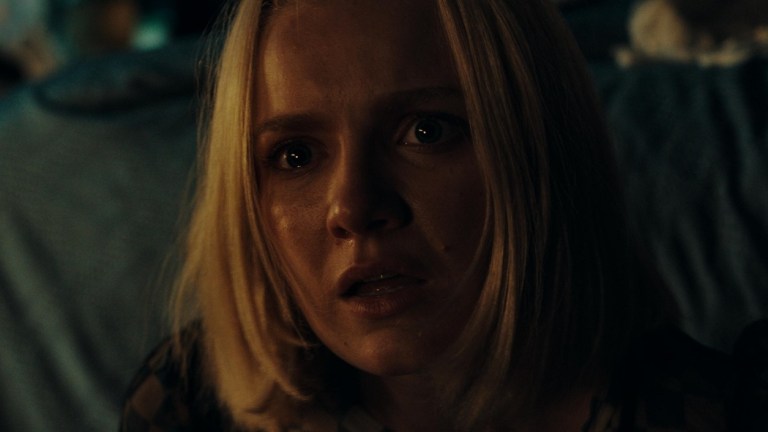Appendage Ending and Meaning Explained
Hulu's Appendage examines Hannah's troubled psyche and manifests it.

This article contains spoilers and discusses mental health issues.
Now that Appendage has finally arrived on Hulu, a larger audience is able to check out writer-director Anna Zlokovic’s first feature film, which is a complex body horror movie that follows Hannah (Hadley Robinson), a beautiful young woman who initially seems to have a lot of positive things happening in her life. Hannah is building a career as an aspiring fashion designer. She has a nice apartment, a loving boyfriend called Kaelin (Brandon Mychal Smith) and a best friend, Esther (Kausar Mohammed), who also works alongside her.
But it’s soon apparent that Hannah is just not doing well. Her mean boss ridicules her designs in front of her colleagues, and her parents seem quite controlling over the way she acts, preferring Hannah to put on a mask of happiness around them and taking drinks away from her. We find out that when she was younger, Hannah had a drinking problem, and once crashed her car. It’s insinuated that it was a deliberate act of self-harm.
It’s all eating away at Hannah, and her anxiety and stress over not being good enough at her job, and being what she considers to be a “defective” person, begin to manifest as the titular appendage – a small, deformed monster that is soon living independently from her body, but with whom she has a important link. The appendage is feeding off Hannah’s mental illness, growing stronger as she grows weaker; fueling her paranoia that she’ll never succeed, and that her boyfriend and best friend are having an affair behind her back.
Hannah also meets a support group who are all coping with the same condition. They are keeping their own appendages at bay by drugging them and locking them up, and they advise Hannah to do the same. It seems that Appendage is attempting to use this as a metaphor for substance abuse, but it is never said outright.
A member of the group, Claudia (Schitt’s Creek star Emily Hampshire), confides in Hannah that she once engaged with her appendage and found it could predict the future. Uncertain, Hannah tries engaging with her monster to see if it has the same psychic power, only for it to overwhelm her and take over her life when she runs out of drugs. Claudia had already been replaced by her own appendage; it was all a trick.
In fact, the entire support group is made up of grown parasites who have replaced their hosts. They have discovered that they can dispense with their hosts and feed on others by exploiting their worst experiences, then sucking the life out of them when they react to the attack. Meanwhile, Hannah’s monster – now a glossy, adult-sized version of her – goes about impressing her boss and flirting with her neglected boyfriend.
Esther notices that the more confident version of Hannah doesn’t have her matching tattoo, and figures out that something bad has happened to her. She rescues Hannah and, after Hannah has regained her strength, they both set about capturing the monster and saving Kaelin, who is in danger of being killed by it. This explores themes about the destructive nature of substance abuse within our relationships, and fears that our problems could become such a burden to our loved ones that they ultimately destroy them.
Appendage Ending and Meaning Explained
Hannah drugs “Claudia”, and severs the draining mechanism between her monster and Kaelin. The monster, unfulfilled, reacts by telling Hannah it hopes she dies. Hannah tells the monster that it’s just not going to happen, and that it’s time to “get used to each other.” At this point, Hannah kisses the monster, and promises that she will take care of it. The monster begins to physically degrade.
Hannah has successfully taken her power back from the darkness that was overwhelming her. Esther says the “perfect” version of Hannah could never truly be her. It will never have the depth, thoughtfulness, and sweetness that Hannah has. She is more self-aware and considered after so many years of coping with her doubts, anxiety and depression, and Kaelin and Esther love her for who she is. Hannah has realized that her pervasive feelings of brokenness are never really going to go away – she must continue to confront them and learn to live with them. It will be a work in progress, but she has begun the journey.
We later see that Hannah has left her demeaning job, and started therapy. She stands up to her parents, demanding that they finally accept that she is going to be sad sometimes. Hannah and Esther have also started a business together. When Hannah pricks her finger sewing, she experiences a horrible rush of her old feelings of uselessness returning, and she admonishes herself harshly for making a mistake.
Hannah cannot control everything, and she will make mistakes. Recognizing that she is letting familiar, negative thoughts in, she immediately stands up and goes upstairs to visit her monster, which has now shrunk to baby size. It is crying, and Hannah soothes it. She is learning to care for the dark part of her that will always have the potential to overwhelm her, but she is no longer letting it grow out of control and take over her life.
If you need urgent help with your mental health, there are resources available. In the US, you can call or text 988 or chat 988lifeline.org. You can also reach Crisis Text Line by texting MHA to 741741, and call 1-800-985-5990 or text “TalkWithUs” to 66746 at the SAMHSA Disaster Distress Helpline, or contact National Suicide Prevention Lifeline 1-800-273-TALK(8255).
If you are in the UK, you can call 116 123 to talk to Samaritans, or email: jo@samaritans.org for a reply within 24 hours. You can text “SHOUT” to 85258 to contact the Shout Crisis Text Line, or text “YM” if you’re under 19. If you’re under 19, you can also call 0800 1111 to talk to Childline.
